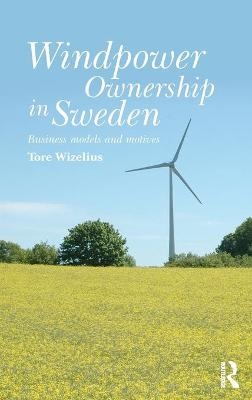
Windpower Ownership in Sweden
Routledge (Verlag)
978-1-138-02111-2 (ISBN)
Windpower is a modular technology, and compared to most other power plants also rather small scale. Wind turbines are installed to the distribution grid, which is called distributed generation. Ownership and revenues can be distributed as well, using the right ownership models.
Several different ownership models, used in different countries, like windpower cooperatives, local limited companies, net-accounting models etc. are described. These models can be used to make windpower become community power, and/or consumer owned power, and produce power for these owners at cost price.
To wait for the international community to agree on international treaties to create a renewable energy system, takes too long. The climate disaster will inevitably happen. To speed up the transition to a renewable energy system, development has to come from below, from local communities, which can initiate and invest in windpower and other renewables. At the same time to get off from the oligopolistic electric power market and produce power at cost price is a good business.
Tore Wizelius is a writer who has authored eight books on windpower. He was a lecturer on windpower at Gotland University from 1998 to 2008 and is now working as a windpower project developer in Sweden.
Acknowledgements Executive Summary 1. Introduction 1.1 Own Your Own Power Plant 1.2 Aim and Research Questions 1.3 Outline 1.4 Personal Background 2. Transition of Socio-technical Systems 2.1 Socio-technical Systems 2.2 Transition to Renewable Energy 3. Windpower in the Electric Power System 3.1 Properties of Windpower Plants 3.2 Integration of Windpower 3.3 Technical Acceptance 3.4 The Electric Power Market 4. Windpower Development and Ownership 4.1 Wind Turbines for Grid Connection 4.2 Ownership 5. Ownership Models in Sweden 5.1 Windpower Business Structure 5.2 Development of Ownership Models 5.3 Corporate Business Models 5.4 Cooperative Business Models 5.5 Real Estate Companies 5.6 Industrial Companies 5.7 Mixed Ownership 5.8 Umbrella Companies 5.9 Summary and Conclusion 6. Windpower Ownership in Sweden 6.1 Windpower development in Sweden 6.2 Ownership Categories 6.3 Other Ownership Categories 6.4 Community Power 6.5 Consumer Windpower 6.6 Summary 7. Windpower Owners’ Motives 7.1 Private Owners 7.2 Windpower Cooperatives 7.3 Windpower Limited Co 7.4 Other Companies 7.5 Power Companies 7.6 Municipalities & Municipal Utilities 7.7 Motives for Investments in Windpower 8. The Relevance of Windpower Ownership 8.1 Summary of Findings 8.2 Networks with Windpower 8.3 Advantages and Disadvantages 8.4 Adaption of Laws, Rules and Regulations 9. Future Outlook 9.1 Conclusions 9.2 Future Research References Appendix Appendix A. Interviews Appendix B. The Electric Power System Appendix C. The Nord Pool Market Appendix D. Windpower Owners in Sweden Appendix E. Abbreviations
| Zusatzinfo | 9 Tables, black and white; 53 Illustrations, black and white |
|---|---|
| Verlagsort | London |
| Sprache | englisch |
| Maße | 156 x 234 mm |
| Gewicht | 570 g |
| Themenwelt | Naturwissenschaften ► Biologie ► Ökologie / Naturschutz |
| Naturwissenschaften ► Physik / Astronomie | |
| Technik ► Elektrotechnik / Energietechnik | |
| Technik ► Umwelttechnik / Biotechnologie | |
| ISBN-10 | 1-138-02111-3 / 1138021113 |
| ISBN-13 | 978-1-138-02111-2 / 9781138021112 |
| Zustand | Neuware |
| Haben Sie eine Frage zum Produkt? |
aus dem Bereich


